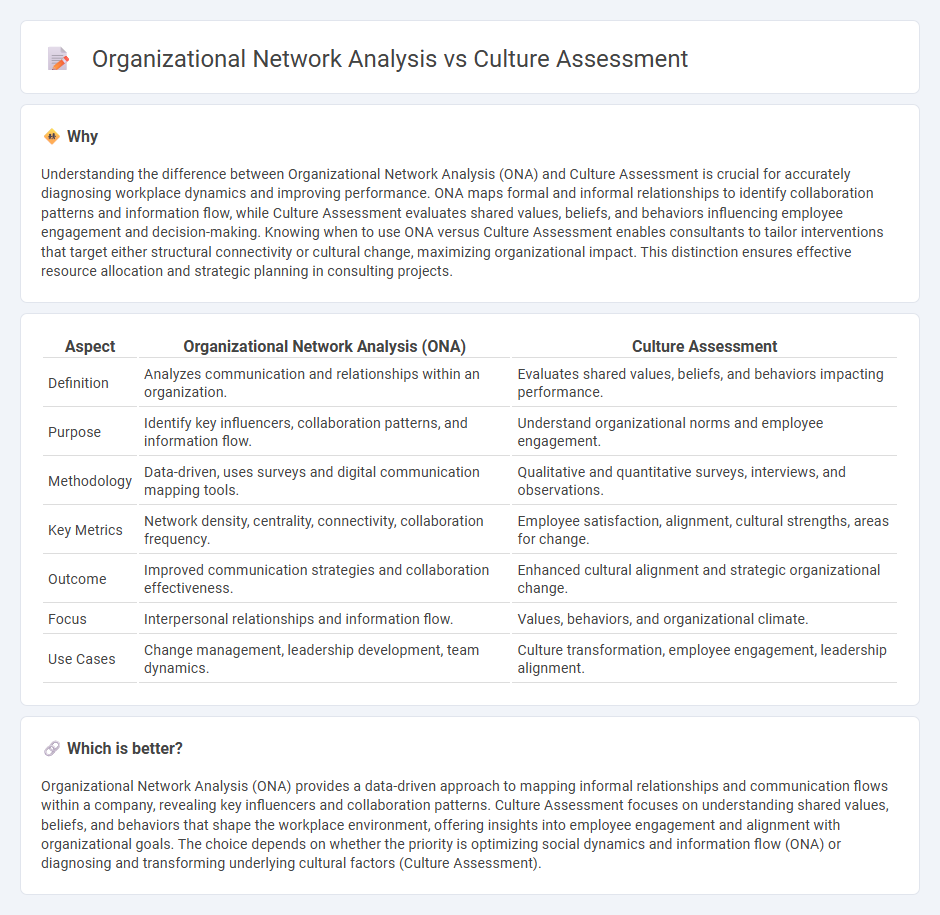
Organizational network analysis (ONA) maps relationships and information flow within a company to identify key influencers and collaboration patterns, while culture assessment evaluates shared values, beliefs, and behaviors impacting employee engagement and performance. Combining ONA with culture assessment offers a comprehensive view of both structural dynamics and cultural elements shaping organizational effectiveness. Explore how integrating these approaches can transform consulting strategies and drive meaningful change.
Why it is important
Understanding the difference between Organizational Network Analysis (ONA) and Culture Assessment is crucial for accurately diagnosing workplace dynamics and improving performance. ONA maps formal and informal relationships to identify collaboration patterns and information flow, while Culture Assessment evaluates shared values, beliefs, and behaviors influencing employee engagement and decision-making. Knowing when to use ONA versus Culture Assessment enables consultants to tailor interventions that target either structural connectivity or cultural change, maximizing organizational impact. This distinction ensures effective resource allocation and strategic planning in consulting projects.
Comparison Table
| Aspect | Organizational Network Analysis (ONA) | Culture Assessment |
|---|---|---|
| Definition | Analyzes communication and relationships within an organization. | Evaluates shared values, beliefs, and behaviors impacting performance. |
| Purpose | Identify key influencers, collaboration patterns, and information flow. | Understand organizational norms and employee engagement. |
| Methodology | Data-driven, uses surveys and digital communication mapping tools. | Qualitative and quantitative surveys, interviews, and observations. |
| Key Metrics | Network density, centrality, connectivity, collaboration frequency. | Employee satisfaction, alignment, cultural strengths, areas for change. |
| Outcome | Improved communication strategies and collaboration effectiveness. | Enhanced cultural alignment and strategic organizational change. |
| Focus | Interpersonal relationships and information flow. | Values, behaviors, and organizational climate. |
| Use Cases | Change management, leadership development, team dynamics. | Culture transformation, employee engagement, leadership alignment. |
Which is better?
Organizational Network Analysis (ONA) provides a data-driven approach to mapping informal relationships and communication flows within a company, revealing key influencers and collaboration patterns. Culture Assessment focuses on understanding shared values, beliefs, and behaviors that shape the workplace environment, offering insights into employee engagement and alignment with organizational goals. The choice depends on whether the priority is optimizing social dynamics and information flow (ONA) or diagnosing and transforming underlying cultural factors (Culture Assessment).
Connection
Organizational network analysis (ONA) maps and measures relationships and communication patterns within a company, revealing cultural dynamics that influence collaboration and decision-making. Culture assessment evaluates shared values, beliefs, and behaviors that shape employee interactions, which are often illuminated through ONA data. Combining these tools enables consultants to identify cultural strengths and barriers, driving targeted interventions for improved organizational effectiveness.
Key Terms
**Culture Assessment:**
Culture assessment evaluates shared values, beliefs, and behaviors within an organization to understand its internal environment and employee engagement levels. It identifies cultural strengths and gaps that impact performance, guiding strategic initiatives for improving workplace climate and alignment with organizational goals. Discover more about how culture assessment drives transformation and sustained success.
Values Alignment
Culture assessment evaluates an organization's core values to determine alignment between employee behaviors and stated principles, fostering a cohesive work environment. Organizational network analysis maps informal relationships and communication patterns, revealing how values flow and are reinforced through social connections. Explore more to understand how integrating both approaches enhances values alignment and organizational performance.
Behavior Norms
Culture assessment evaluates behavior norms by examining shared values, beliefs, and practices that shape employee interactions within an organization. Organizational Network Analysis (ONA) identifies behavior norms by mapping informal relationships and communication patterns among employees, revealing how information flows and social influence operates. Explore deeper insights into how these approaches complement each other in understanding and shaping workplace behavior norms.
Source and External Links
Culture Assessments: Types, Benefits, & Sample Questions - This article outlines the importance of conducting cultural assessments to analyze workplace culture and provides steps for a successful assessment.
Cultural Assessments: What They Are and How To Conduct One - This resource explains what cultural assessments are and how they help organizations evaluate and improve their workplace culture.
What Is a Cultural Assessment? How To Perform Yours in 8 Steps - This article provides a step-by-step guide on how to perform a cultural assessment, helping organizations enhance employee engagement and culture.
 dowidth.com
dowidth.com